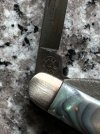jon303
Gold Member
- Joined
- Oct 12, 1998
- Messages
- 276
Hello,
Bought a Case abalone whittler for my dad back in the late 90s IIRC. He gave it back to me somewhat recently as it had a lot (A LOT) of surface rust and pitting.
I attempted to remove the rust chemically and while the rust situation improved I think the chemicals inadvertently weakened the spring which has since snapped.
I emailed Case Customer Service and they suggested reaching out to Parker’s Knife Collectors Service. The only contact info I could find was a number and address in Chattanooga TN and wanted to ask if anyone else had any luck reaching Parker’s Service (does it still exist?)?
From what I had read Jim Parker previously owned Case and produced the Case Classics during that time frame.
If I’m SOL are there any recommendations from folks for who might be able to repair (with cost of course)?
This is the email I received from Case Support
“
Our repair technicians evaluated your knife and determined your knife is part of the “Case Classics” line and was not manufactured by W.R. Case & Sons Cutlery Company. The legal rights for this line were held exclusively by James Parker from 1988 to 1998. The “Case Classics” knives produced during this time frame carry their own warranty. Details about these products may be obtained through Parkers’ Knife Collectors Service.
We are sorry we are unable to comply with your repair request.”
Thanks!
Bought a Case abalone whittler for my dad back in the late 90s IIRC. He gave it back to me somewhat recently as it had a lot (A LOT) of surface rust and pitting.
I attempted to remove the rust chemically and while the rust situation improved I think the chemicals inadvertently weakened the spring which has since snapped.
I emailed Case Customer Service and they suggested reaching out to Parker’s Knife Collectors Service. The only contact info I could find was a number and address in Chattanooga TN and wanted to ask if anyone else had any luck reaching Parker’s Service (does it still exist?)?
From what I had read Jim Parker previously owned Case and produced the Case Classics during that time frame.
If I’m SOL are there any recommendations from folks for who might be able to repair (with cost of course)?
This is the email I received from Case Support
“
Our repair technicians evaluated your knife and determined your knife is part of the “Case Classics” line and was not manufactured by W.R. Case & Sons Cutlery Company. The legal rights for this line were held exclusively by James Parker from 1988 to 1998. The “Case Classics” knives produced during this time frame carry their own warranty. Details about these products may be obtained through Parkers’ Knife Collectors Service.
We are sorry we are unable to comply with your repair request.”
Thanks!






